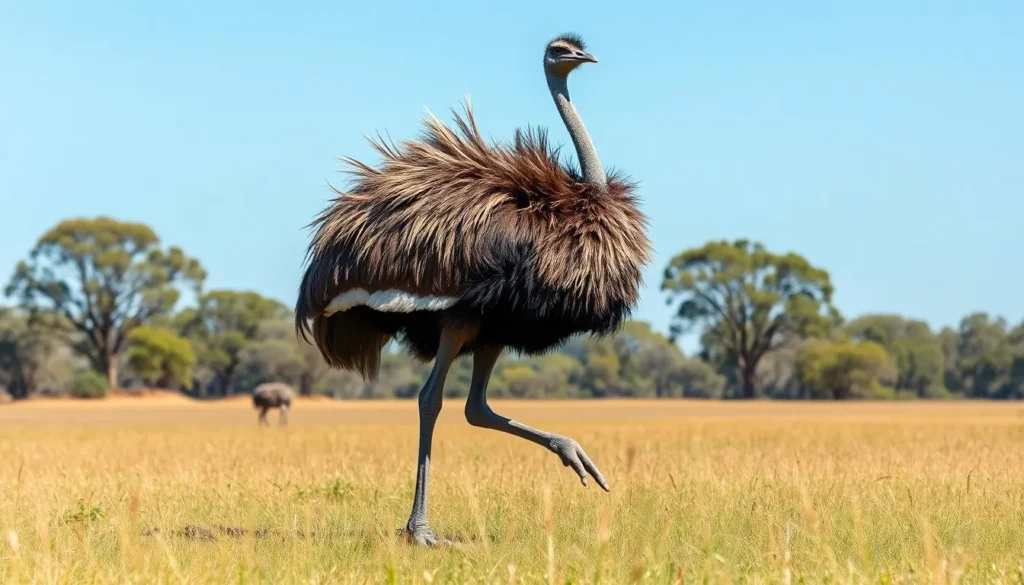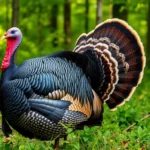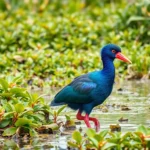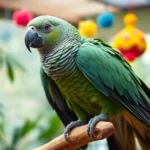When we think of Australia’s most iconic birds we often picture colorful parrots or kookaburras. But there’s another feathered giant that deserves our attention – the magnificent emu. Standing nearly six feet tall and weighing up to 130 pounds these flightless birds are Australia’s largest native species and the industry’s second-largest living bird.
We’ve discovered that emus are far more fascinating than most people realize. These ancient creatures have roamed the Australian continent for millions of years developing incredible survival skills and unique behaviors that continue to amaze researchers today. From their powerful legs that can reach speeds of 30 mph to their distinctive deep booming calls that can be heard from miles away emus are truly remarkable animals.
Whether you’re planning an Australian adventure or simply curious about these extraordinary birds we’re here to share everything you need to know about the incredible emu.
What Is an Emu Bird?
An emu bird represents Australia’s second largest bird species globally and serves as the country’s national bird. These remarkable flightless birds belong to the ratite family and roam across diverse Australian landscapes with distinctive features that set them apart from other avian species.
Physical Characteristics and Size
Emus display impressive physical dimensions that make them unmistakable in the wild. Adult emus reach heights between 5 to 6.2 feet (1.5 to 1.9 meters) and weigh approximately 80 to 130 pounds (36 to 59 kilograms). Their bodies feature long necks that extend gracefully upward and powerful legs capable of covering important distances.
The emu’s plumage consists of double shaft feathers that create a distinctive shaggy appearance. Each feather splits into two separate shafts, giving these birds their characteristic fluffy texture. Their coloration ranges from brown to grayish brown, providing excellent camouflage in Australia’s diverse terrains.
Powerful legs equipped with three forward facing toes enable emus to achieve remarkable speeds. These birds can sprint up to 30 miles per hour (48 kilometers per hour) when necessary. Their wings remain small and vestigial, measuring only 8 inches (20 centimeters) in length, making flight impossible even though their bird classification.
Emu vs Ostrich: Key Differences
| Feature | Emu | Ostrich |
|---|---|---|
| Height | 5-6.2 feet (1.5-1.9 meters) | 6-9 feet (1.8-2.7 meters) |
| Weight | 80-130 pounds (36-59 kg) | 220-350 pounds (100-159 kg) |
| Native Location | Australia | Africa |
| Toe Count | 3 toes | 2 toes |
| Neck Feathers | Feathered neck | Bare neck |
| Running Speed | 30 mph (48 km/h) | 45 mph (72 km/h) |
Distinguishing emus from ostriches becomes straightforward when examining exact anatomical features. Emus possess three toes on each foot while ostriches have only two toes per foot. The emu’s neck remains fully feathered unlike the ostrich’s bare neck and head region.
Geographic distribution creates another clear distinction between these ratite species. Emus exclusively inhabit Australian territories while ostriches naturally occur throughout African savannas and deserts. Size differences also separate these birds, with ostriches significantly larger and heavier than their Australian counterparts.
Behavioral patterns reveal additional contrasts between emu birds and ostriches. Male emus take primary responsibility for incubating eggs and raising chicks, while ostrich parenting involves both males and females in different capacities. These fundamental differences highlight the unique evolutionary paths each species has taken in their respective continents.
Natural Habitat and Distribution
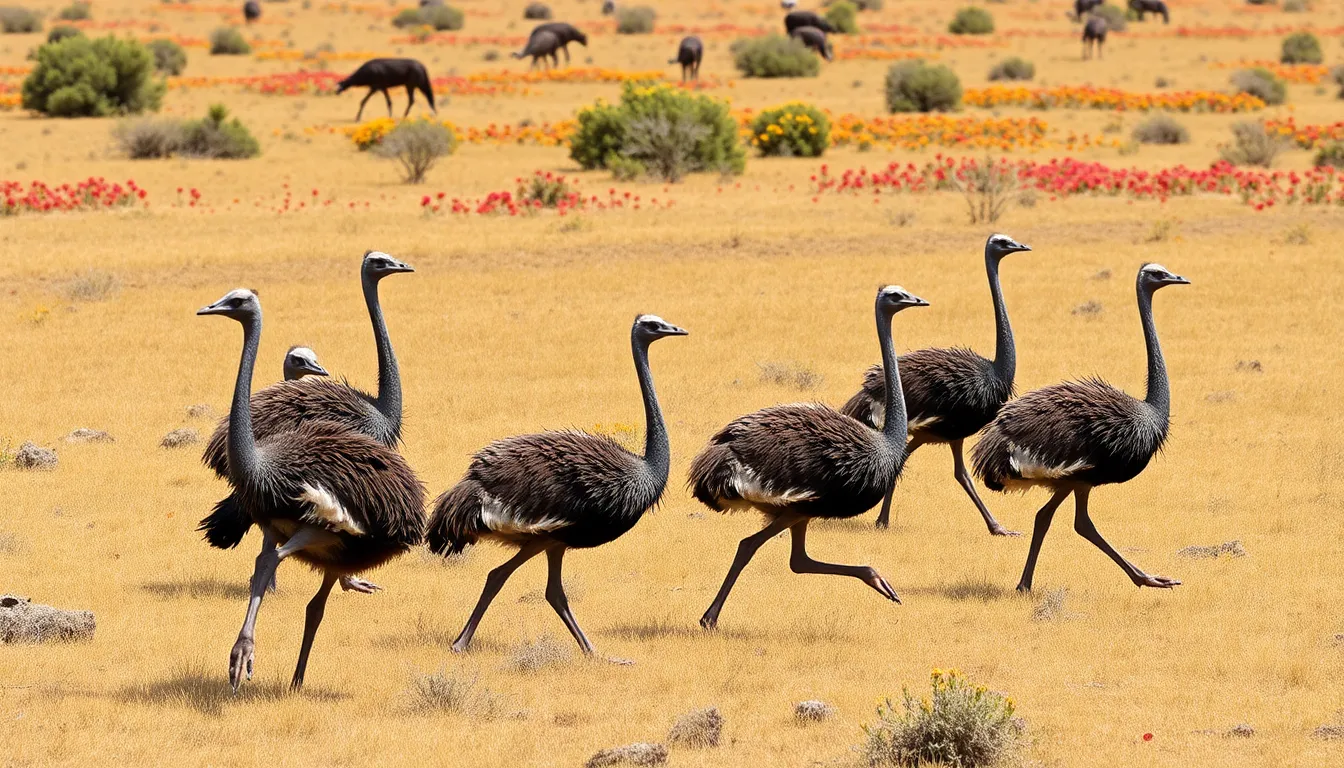
Emus roam across virtually every corner of the Australian continent, making them one of the most widely distributed native bird species. These remarkable flightless birds have adapted to thrive in diverse environments throughout their homeland.
Where Emus Live in the Wild
Australia serves as the exclusive home for wild emu populations, with these birds inhabiting all mainland states and territories. We find emus across Western Australia, South Australia, Victoria, New South Wales, Queensland, and the Northern Territory. Tasmania lacks native emu populations due to geographic separation from the mainland.
Emus occupy an impressive range spanning approximately 2.97 million square miles of Australian territory. Eastern Australia supports the highest population densities, particularly in New South Wales and Queensland regions. Western Australia hosts substantial emu numbers across its vast interior landscapes. Central Australia provides critical habitat corridors connecting eastern and western populations.
Desert regions, semi-arid zones, grasslands, and open woodlands all support thriving emu communities. Coastal areas occasionally attract emus, though they prefer inland territories with abundant food sources. Agricultural zones frequently overlap with natural emu habitats, creating both opportunities and challenges for these adaptable birds.
Habitat Requirements and Preferences
Open landscapes with scattered vegetation provide optimal emu habitat conditions. We observe emus favoring areas with 10 to 30 inches of annual rainfall, supporting diverse plant communities for foraging. Grasslands mixed with shrublands offer ideal combinations of food sources and nesting sites.
Water access remains essential for emu survival, with populations concentrating within 6 miles of reliable water sources. Seasonal wetlands, permanent water holes, and artificial water points all serve emu hydration needs. Drought conditions force emus to travel considerable distances seeking water and suitable foraging grounds.
| Habitat Type | Rainfall Range | Population Density | Key Features |
|---|---|---|---|
| Semi-arid grasslands | 10-20 inches | High | Scattered shrubs, seasonal flowers |
| Open woodlands | 15-30 inches | Moderate | Eucalyptus trees, diverse understory |
| Desert margins | 5-15 inches | Low | Hardy vegetation, water holes |
| Agricultural areas | 15-40 inches | Variable | Crop fields, pastures, fencing |
Emus avoid dense forests where their large size becomes disadvantageous for movement and predator detection. Mountain ranges and heavily urbanized areas see minimal emu presence due to habitat fragmentation. Flat to gently rolling terrain supports optimal emu mobility and foraging efficiency.
Seasonal movements characterize emu behavior patterns, with birds following food availability and weather conditions. Northern populations migrate southward during dry seasons, while southern groups may move toward coastal areas during harsh winters. These movements can span hundreds of miles as emus track favorable conditions across their expansive range.
Emu Behavior and Social Structure

Emus demonstrate complex behavioral patterns that reflect their adaptability to Australia’s diverse environments. We observe fascinating social dynamics and behavioral adaptations that distinguish these remarkable birds from other ratite species.
Daily Activities and Movement Patterns
Emus exhibit crepuscular activity patterns, meaning they’re most active during dawn and dusk hours when temperatures remain moderate. During peak summer heat, these birds rest in shaded areas and pant to regulate their body temperature.
Foraging behavior dominates much of their daily routine. Emus spend 8 to 10 hours each day searching for food, consuming fruits, seeds, insects, and vegetation. They use their powerful beaks to strip leaves from plants and can swallow stones weighing up to 45% of their stomach contents to aid digestion.
Movement patterns vary significantly based on seasonal conditions and food availability. Emus travel in loose flocks of 3 to 20 individuals outside breeding season, covering distances of 15 to 25 kilometers daily while foraging. During drought periods, they migrate up to 500 kilometers to locate water sources and suitable feeding grounds.
Social interactions remain relatively peaceful among non-breeding adults. Emus communicate through deep booming sounds that can travel distances exceeding 2 kilometers. Males produce these vocalizations using an inflatable throat pouch, creating frequencies as low as 32 Hz.
Mating Rituals and Breeding Season
Emu breeding season occurs during Australian winter months, typically from May through August when food resources become more abundant. Males initiate elaborate courtship displays by circling females while producing deep drumming sounds and inflating their throat pouches.
Courtship behaviors include males performing ritualized dances where they sway their necks, ruffle their feathers, and make soft grunting noises. Successful males may mate with multiple females during a single breeding season, with each female capable of laying 5 to 15 dark green eggs.
Nesting responsibilities fall exclusively to male emus once mating concludes. Males construct shallow ground nests using grass, bark, and leaves, creating depressions approximately 1 meter wide. The incubation period lasts 56 days, during which males rarely leave the nest except for brief feeding periods.
Parental care extends beyond hatching, as male emus remain with their striped chicks for 5 to 6 months. Chicks weigh approximately 500 grams at hatching and grow rapidly, reaching adult size within 12 to 14 months. Males teach their offspring essential survival skills including foraging techniques, predator recognition, and safe water sources.
Diet and Feeding Habits

Emus maintain an omnivorous diet that adapts to seasonal food availability across Australia’s diverse landscapes. These remarkable birds consume over 45,000 different food items throughout their lifetime, making them one of nature’s most versatile foragers.
What Emus Eat in the Wild
Plant materials form the foundation of emu nutrition, comprising approximately 90% of their total food intake during most seasons. Fruits constitute their preferred food source, with emus consuming native berries like quandong, desert lime, and emu apple when available. Seeds from acacia trees, saltbush, and various grasses provide essential carbohydrates and fats for energy storage.
Green vegetation becomes increasingly important during spring months when fresh shoots and leaves offer high nutritional content. Emus actively seek flowers from banksia, grevillea, and eucalyptus trees for their nectar and pollen content. Agricultural crops including wheat, corn, and lucerne attract emus to farming areas, though this behavior sometimes creates conflicts with farmers.
Animal protein supplements their plant-based diet through insects like beetles, caterpillars, grasshoppers, and ants. Small vertebrates including lizards, frogs, and occasionally fish provide additional protein sources. Stones and pebbles consumed by emus aid digestion by grinding food materials in their muscular gizzards.
Foraging Techniques and Food Sources
Ground foraging represents the primary feeding strategy for emus, who use their strong legs to scratch and dig through soil layers. Their flexible necks allow them to reach food items up to 3 feet below ground level while maintaining visual awareness of surroundings. Pecking motions help emus extract seeds from hard casings and capture fast-moving insects.
Seasonal migration patterns align with food abundance, as emus track ripening fruit cycles across different regions. During drought periods, these birds concentrate near water sources where vegetation remains green and insects gather. Opportunistic feeding behaviors enable emus to exploit temporary food sources like road-killed animals or discarded agricultural produce.
Group foraging occurs when food sources are abundant, with multiple emus working the same area while maintaining loose social spacing. Individual birds can consume up to 1.5 pounds of food daily during peak feeding periods. Morning and evening feeding sessions coincide with cooler temperatures and increased insect activity, optimizing energy expenditure during foraging activities.
Emu Life Cycle and Reproduction

Emu reproduction follows a unique pattern where males take complete responsibility for nesting and chick rearing. The breeding season occurs during Australia’s cooler months from May to September when food resources become more abundant.
Egg Laying and Incubation Process
Female emus produce distinctive dark green eggs during the breeding season after elaborate courtship rituals. Each egg measures approximately 5.5 inches long and 3.5 inches wide, weighing between 1.3 to 1.8 pounds. Females lay between 5 to 24 eggs per clutch, with the average clutch containing 8 to 12 eggs.
Males construct shallow nests on the ground using grass, leaves, and bark materials. The nest depression measures about 3 feet in diameter and provides protection from wind and predators. Once egg laying begins, females deposit one egg every 2 to 4 days until the clutch is complete.
Incubation becomes the male’s exclusive responsibility for approximately 56 days. Males rarely leave the nest during this period, losing up to 30% of their body weight while maintaining constant egg temperature. They rotate the eggs regularly to ensure proper development and turn them completely every few hours to prevent the embryos from sticking to the shell walls.
Raising Emu Chicks
Newly hatched emu chicks emerge from their shells after using their egg tooth to break through the tough shell. Chicks weigh approximately 0.5 pounds at hatching and stand about 5 inches tall. Their distinctive cream and brown striped plumage provides camouflage protection during their vulnerable early weeks.
Male emus guide their offspring for 5 to 6 months after hatching, teaching essential foraging techniques and predator avoidance behaviors. Chicks follow their father closely, learning to identify safe food sources and water locations. The male produces soft grunting sounds to communicate with his young and alert them to potential dangers.
Juvenile emus reach sexual maturity between 18 to 24 months of age when they develop their adult plumage. Young birds grow rapidly during their first year, reaching approximately 75% of their adult size by 12 months. The family group gradually disperses as the chicks become more independent and begin establishing their own territories.
Cultural Significance and Economic Impact
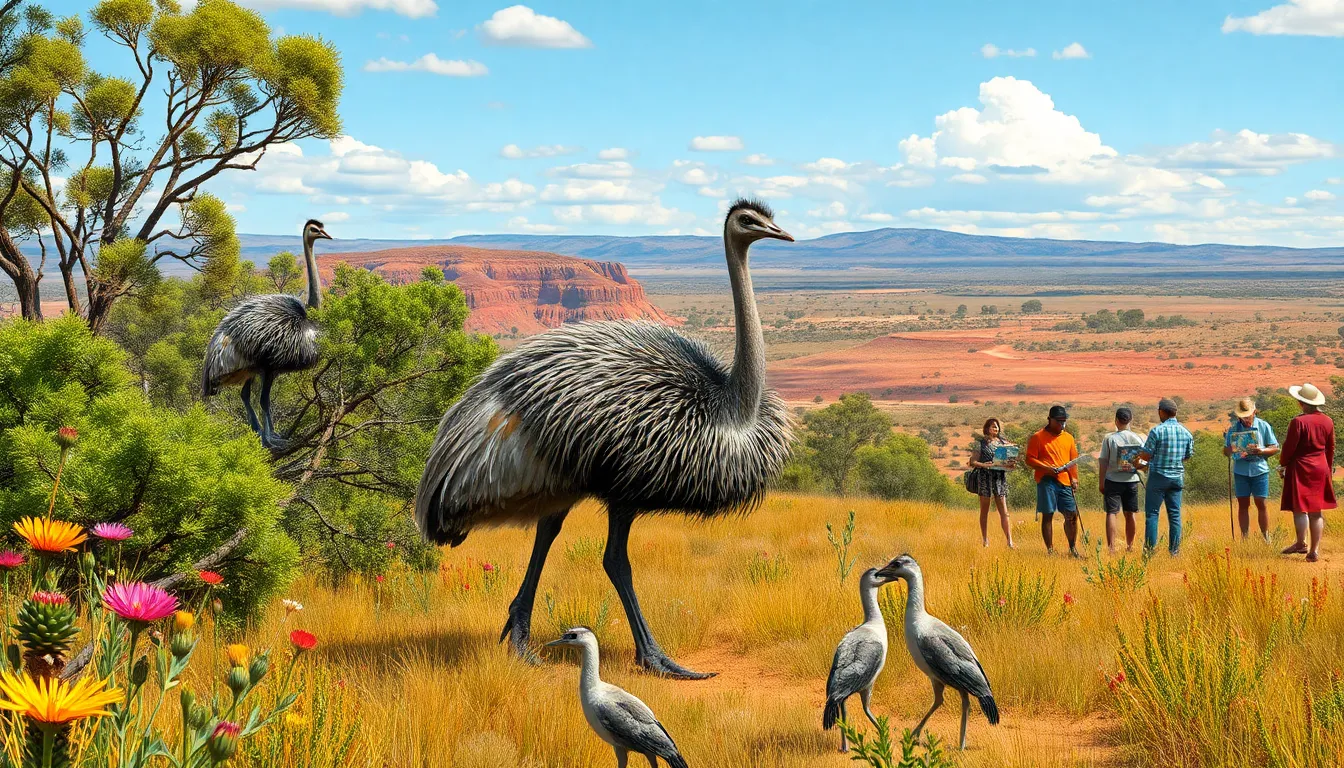
The emu’s influence extends far beyond Australia’s natural ecosystems into the heart of the nation’s cultural identity and economic industry. These remarkable birds have shaped Australian heritage while creating substantial commercial opportunities across multiple industries.
Emus in Australian Culture
Australia’s national bird holds profound cultural significance that spans thousands of years of Aboriginal heritage and modern national identity. Indigenous communities across the continent have revered emus for over 60,000 years, incorporating these birds into creation stories, traditional art, and ceremonial practices. The Dreaming stories of various Aboriginal groups feature emus as ancestral beings who shaped the industry and taught important life lessons.
Modern Australian culture embraces the emu as a symbol of resilience and adaptability. The bird appears prominently on Australia’s coat of arms alongside the kangaroo, representing the nation’s forward-moving spirit since neither animal can walk backwards. This symbolism resonates throughout Australian society, from government institutions to sporting teams.
Cultural festivals across Australia celebrate the emu’s significance through art exhibitions, storytelling events, and educational programs. The annual Emu Plains Festival in New South Wales attracts over 25,000 visitors who participate in emu-themed activities and learn about conservation efforts. Artists regularly feature emus in contemporary works, with Aboriginal dot paintings and sculptures commanding prices exceeding $50,000 in international markets.
Tourism operators capitalize on the emu’s cultural appeal by offering wildlife experiences that generate approximately $2.3 billion annually for the Australian economy. Visitors from over 80 countries specifically seek emu encounters during their Australian travels, with wildlife parks reporting emu interactions as the third most popular attraction after kangaroo and koala experiences.
Commercial Emu Farming
Australia’s emu farming industry has evolved into a sophisticated commercial enterprise worth $15 million annually, supporting over 800 farming operations across the continent. Commercial farmers maintain approximately 40,000 emus in captivity, with breeding pairs producing 20 to 50 eggs per season depending on environmental conditions and management practices.
Emu meat production represents the largest segment of commercial farming, generating $8.2 million in annual revenue. The meat contains 97% less fat than beef and provides 23 grams of protein per 100-gram serving, making it increasingly popular among health-conscious consumers. Restaurants in Melbourne, Sydney, and Perth feature emu steaks on their menus, with premium cuts selling for $45 per kilogram at specialty retailers.
Oil extraction from emu fat creates another lucrative market segment worth $4.1 million yearly. Cosmetic manufacturers incorporate emu oil into anti-aging creams, moisturizers, and therapeutic products due to its high concentration of omega fatty acids. The pharmaceutical industry uses refined emu oil in topical medications for arthritis and muscle pain, with clinical studies showing 40% improvement in joint mobility among patients using emu oil treatments.
Leather production from emu hides contributes $2.7 million to the industry’s annual value. Fashion designers prize emu leather for its distinctive texture and durability, creating handbags, boots, and belts that retail for $200 to $800 per item. The leather’s unique grain pattern and flexibility make it particularly suitable for luxury accessories and specialty footwear.
Export markets in Asia, Europe, and North America consume 70% of Australia’s emu products, with Japan and South Korea representing the largest international customers. Trade agreements help emu product exports worth $10.5 million annually, supporting rural communities and providing alternative income sources for traditional livestock farmers facing drought conditions.
Conservation Status and Challenges
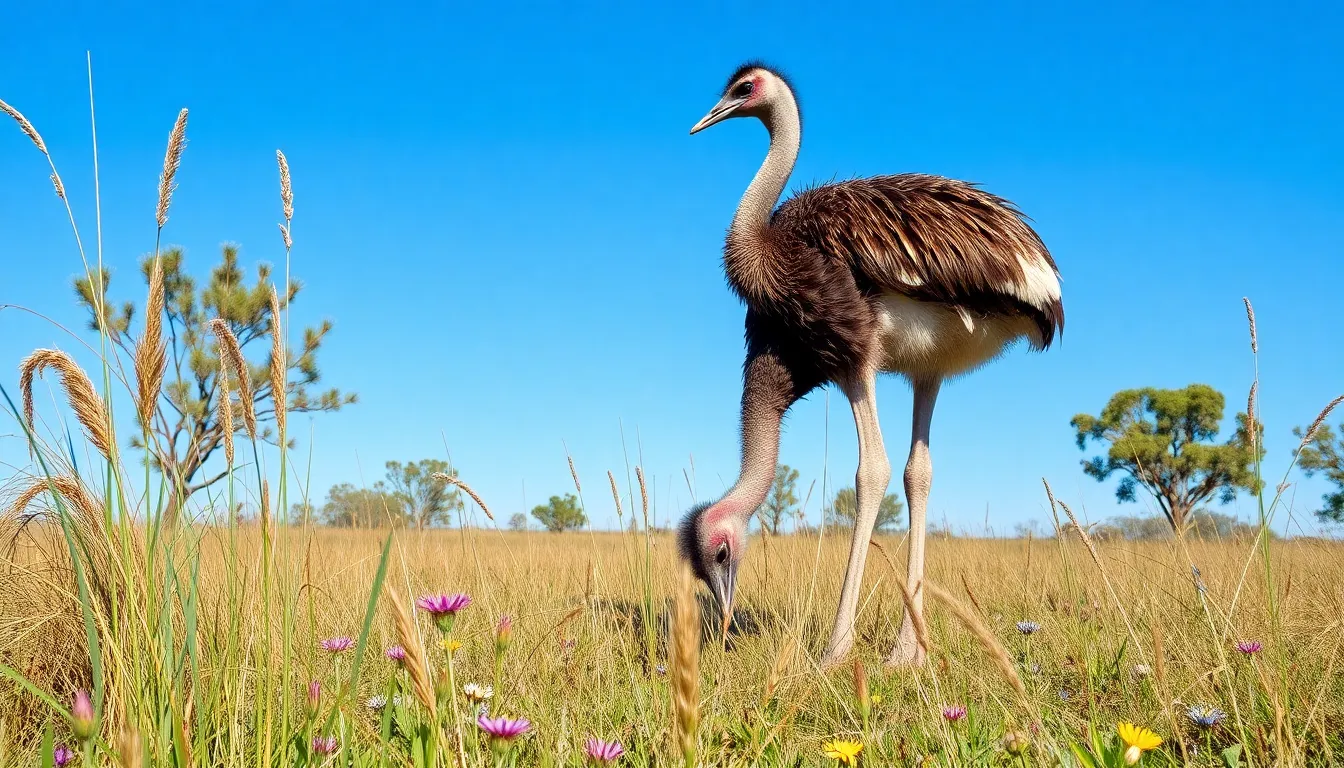
Emu populations currently maintain stable numbers across Australia with approximately 630,000 to 725,000 individuals recorded in recent surveys. The International Union for Conservation of Nature classifies the emu as “Least Concern” on their Red List due to widespread distribution and healthy population levels. But, regional variations exist with some localized populations experiencing pressure from human activities and environmental changes.
Historical population declines affected emu numbers during the 20th century when habitat loss and hunting reduced their range. European settlement patterns disrupted traditional migration routes and eliminated populations from Tasmania and King Island between 1850 and 1960. Agricultural development converted millions of hectares of natural habitat into farmland, forcing emus to adapt to fragmented landscapes.
Modern conservation challenges include climate change impacts on food availability and water sources. Extended drought periods force emus to travel longer distances for resources, increasing mortality rates among juvenile birds. Urban expansion continues to fragment habitats, particularly in coastal regions where human populations concentrate.
| Conservation Challenge | Impact Level | Primary Threat |
|---|---|---|
| Habitat fragmentation | Moderate | Urban development |
| Vehicle strikes | High | Road mortality |
| Fence entanglement | Moderate | Agricultural barriers |
| Climate variability | Increasing | Drought conditions |
Human-wildlife conflicts arise when emus damage crops or enter urban areas searching for food and water. Farmers report crop losses exceeding $2 million annually from emu foraging activities, particularly in wheat and canola fields. Vehicle collisions account for approximately 10,000 emu deaths per year on Australian highways, making road mortality a important conservation concern.
Protective legislation safeguards emus under various state and federal wildlife protection acts. Hunting permits require strict regulation in states where culling occurs to manage agricultural damage. The Australian government monitors population trends through national bird surveys conducted every five years.
Conservation success stories demonstrate effective management strategies in several regions. Corridor restoration projects reconnect fragmented habitats, allowing natural movement patterns to resume. Farmers increasingly carry out emu-friendly fencing designs that prevent entanglement while maintaining property boundaries. Wildlife crossing structures reduce vehicle collisions by 40% in high-traffic areas where they’ve been installed.
Conclusion
We’ve explored the remarkable industry of Australia’s most iconic flightless bird and discovered why emus continue to captivate wildlife enthusiasts worldwide. These extraordinary creatures represent far more than just another bird species – they’re living symbols of Australia’s unique biodiversity and cultural heritage.
From their impressive physical capabilities to their crucial role in Aboriginal traditions emus demonstrate the incredible adaptability that’s allowed them to thrive across an entire continent. Their economic contributions through sustainable farming practices further highlight how wildlife conservation and human prosperity can work hand in hand.
As we move forward it’s clear that protecting emu populations isn’t just about preserving a single species – it’s about maintaining the delicate balance of Australia’s ecosystems. We encourage everyone to appreciate these magnificent birds and support conservation efforts that ensure future generations can witness their grace in the wild.
Frequently Asked Questions
What is an emu and where are they found?
Emus are Australia’s largest native bird and second largest bird species globally, belonging to the ratite family of flightless birds. They are found across virtually every corner of the Australian continent, inhabiting all mainland states and territories. These iconic birds thrive in diverse environments including deserts, grasslands, and open woodlands while avoiding dense forests and urban areas.
How big do emus get and what do they look like?
Adult emus reach heights of 5 to 6.2 feet and weigh between 80 to 130 pounds. They have distinctive shaggy, double-shafted feathers that appear brown or grayish-brown, powerful legs with three toes each, and a fully feathered neck. Their unique plumage provides excellent insulation and helps them blend into their natural environment.
How fast can emus run?
Emus can sprint at impressive speeds of up to 30 miles per hour (48 km/h). Their powerful legs and lightweight build make them excellent runners, allowing them to escape predators and cover large distances during their seasonal migrations. This speed, combined with their endurance, makes them one of Australia’s most mobile bird species.
What do emus eat?
Emus are omnivorous and consume over 45,000 different food items throughout their lifetime. Their diet consists of approximately 90% plant materials including native fruits, seeds, leaves, and flowers, supplemented with insects, small reptiles, and other protein sources. They adapt their feeding habits based on seasonal availability and can migrate hundreds of kilometers following food sources.
How do emus reproduce and care for their young?
During breeding season (May to September), female emus lay distinctive dark green eggs in shallow nests constructed by males. Males take full responsibility for incubating the eggs for about 56 days and caring for the chicks. Father emus guide their offspring for 5-6 months, teaching essential survival skills before the young become independent at 18-24 months.
What’s the difference between emus and ostriches?
While both are large flightless birds, emus are smaller (80-130 lbs vs 220-350 lbs), have three toes instead of two, and possess fully feathered necks compared to ostriches’ bare necks. Emus are native to Australia while ostriches are found in Africa. Additionally, male emus handle all parenting duties, whereas ostrich parenting is shared between both parents.
Are emus endangered?
Emus are currently classified as “Least Concern” by the International Union for Conservation of Nature, with population estimates ranging from 630,000 to 725,000 individuals. However, some localized populations face challenges from habitat loss, vehicle strikes, and human-wildlife conflicts. Conservation efforts focus on habitat protection and promoting coexistence with human communities.
What is the cultural significance of emus in Australia?
Emus hold profound cultural importance in Aboriginal heritage, featuring prominently in creation stories, traditional art, and spiritual beliefs. In modern Australian culture, they symbolize resilience and adaptability, appearing on the national coat of arms alongside the kangaroo. Emus are celebrated in festivals, art exhibitions, and represent the untamed spirit of the Australian outback.
Can you farm emus commercially?
Yes, emu farming is a significant industry in Australia, generating approximately $15 million annually. Emus are raised for their meat, oil, and leather products. Emu meat is popular as a healthy, low-fat protein source, while emu oil is used in cosmetics and therapeutic applications. These products are exported globally, supporting rural communities and providing alternative income for farmers.
When are emus most active?
Emus are crepuscular, meaning they are most active during dawn and dusk hours. They spend 8-10 hours daily foraging for food and typically rest during the hottest parts of the day. This activity pattern helps them conserve energy and avoid extreme temperatures while maximizing their foraging efficiency in their native Australian habitat.

